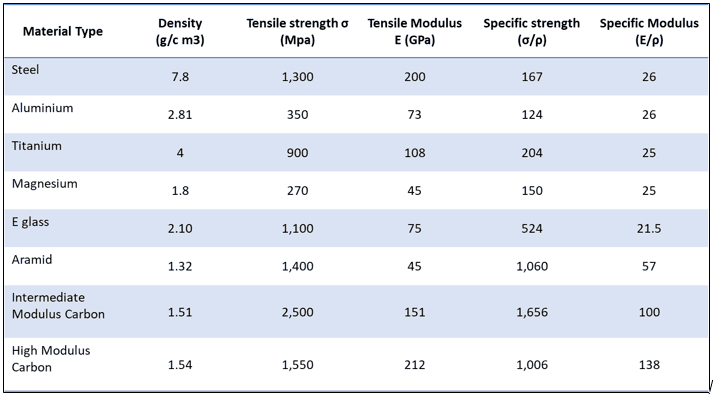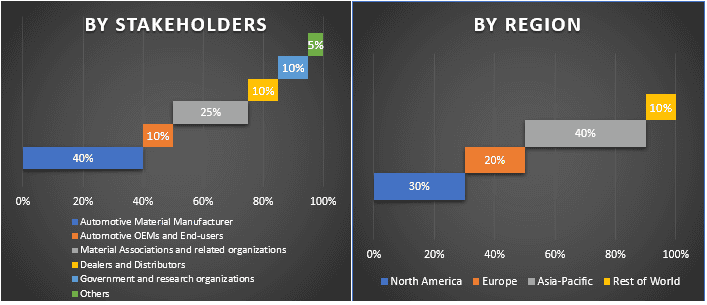- Trang chủ
- Về chúng tôi
- Ngành
- Dịch vụ
- Đọc
- Liên hệ với chúng tôi
Thị trường Vật liệu Nhẹ Ô tô: Phân tích Hiện tại và Dự báo (2021-2027)
Nhấn mạnh vào Loại Vật liệu (Kim loại, Nhựa, Vật liệu Composite, Elastomer); Bộ phận (Khung, Hệ thống truyền động, Các bộ phận nội thất, Các bộ phận ngoại thất); Ứng dụng (Thân xe, Khung gầm và Hệ thống treo, Hệ thống truyền động, Cửa và nắp, Nội thất, Khác); Loại Xe (Xe chở khách, Xe thương mại hạng nhẹ, Xe thương mại hạng nặng); và Khu vực/Quốc gia

Vật liệu nhẹ cho ô tô dự kiến sẽ chứng kiến tốc độ tăng trưởng CAGR hơn 7,3% trong giai đoạn dự báo 2021-2027 để đạt quy mô thị trường khoảng 153,1 tỷ đô la Mỹ vào năm 2027. Trong thập kỷ qua, trọng lượng của xe chở khách liên tục tăng lên để mang lại sự thoải mái và an toàn hơn cho hành khách, điều này đã dẫn đến việc tăng mức tiêu thụ nhiên liệu và khí thải nhà kính từ lĩnh vực ô tô. Sáng kiến chặt chẽ của chính phủ đã làm tăng nhu cầu tổng thể đối với các phương tiện vận tải đường bộ tiết kiệm nhiên liệu hơn, điều này đã dẫn đến sự ra đời của các vật liệu mới như thép cường độ cao mới, vật liệu composite polymer, hợp kim nhôm và magiê trong số các vật liệu nhẹ khác để sản xuất xe. Để đáp ứng nhu cầu ngày càng tăng về giảm khí thải và tăng khả năng tiết kiệm nhiên liệu trên tất cả các loại xe thế hệ mới, ngành thép đã đẩy nhanh việc triển khai các loại thép cải tiến mới so với các vật liệu nhẹ mới nổi khác. Các nhà sản xuất thép đang tham gia vào việc phát triển các loại thép cường độ cao mới cho ngành ô tô, đồng thời nêu bật những lợi ích của nó so với hợp kim nhôm.
So sánh các đặc tính cơ học giữa vật liệu thông thường & composite
Thông tin chi tiết được trình bày trong báo cáo
“Trong số các loại vật liệu, phân khúc kim loại chiếm ưu thế trên thị trường”
Dựa trên loại vật liệu, Thị trường vật liệu nhẹ cho ô tô được phân chia thành Kim loại, Nhựa, Vật liệu composite, Chất đàn hồi. Phân khúc composite dự kiến sẽ chứng kiến sự tăng trưởng đáng kể trong giai đoạn dự báo. Các vật liệu nhẹ bao gồm nhôm, magiê, beryli, titan, titan aluminide, gốm cấu trúc, vật liệu composite với polymer, kim loại, vật liệu gốm đã nổi lên như một yếu tố cần thiết cho chiến lược giảm trọng lượng cho các OEM ô tô.
“Trong số các thành phần, phân khúc hệ thống truyền động sẽ chứng kiến sự tăng trưởng đáng kể”
Dựa trên thành phần, Thị trường vật liệu nhẹ cho ô tô được chia thành khung, hệ thống truyền động, các thành phần nội thất, các thành phần bên ngoài. Việc sử dụng nhôm làm vật liệu nhẹ trong sản xuất xe chủ yếu giới hạn ở hộp số động cơ, bộ trao đổi nhiệt bánh xe, khung gầm và hệ thống treo. Ví dụ về ứng dụng Magiê (Mg) bao gồm bảng điều khiển, vô lăng, ghế động cơ, hộp chuyển số, v.v.
“Trong số các ứng dụng, phân khúc hệ thống truyền động sẽ chứng kiến sự tăng trưởng đáng kể”
Dựa trên ứng dụng, Thị trường vật liệu nhẹ cho ô tô được chia thành thân xe, khung gầm và hệ thống treo, hệ thống truyền động, hệ thống đóng, nội thất, những loại khác. Chất đàn hồi là polyme do đặc tính nhớt đàn hồi cao của chúng được sử dụng trong sản xuất các bộ phận cần chịu được nhiệt độ khắc nghiệt như ống mềm, vật liệu cách nhiệt, vòng đệm, ống lót, giá đỡ động cơ và miếng đệm.
“Trong số các loại xe, phân khúc xe chở khách chiếm ưu thế trên thị trường”
Dựa trên loại xe, Thị trường vật liệu nhẹ cho ô tô được chia thành xe chở khách, xe thương mại hạng nhẹ, xe thương mại hạng nặng. Phân khúc xe chở khách dự kiến sẽ chứng kiến sự tăng trưởng đáng kể trong giai đoạn dự báo. Ứng dụng chính của nhôm trong xe điện là vỏ pin tấm nhôm có thể kéo dài phạm vi lái xe của xe và cho phép xe di chuyển thêm 10% cho một lần sạc.
“Châu Á - Thái Bình Dương dự kiến sẽ chứng kiến sự tăng trưởng đáng kể trong giai đoạn dự báo”
Để hiểu rõ hơn về nhu cầu về vật liệu nhẹ cho ô tô, thị trường được phân tích cho các khu vực chính bao gồm Bắc Mỹ (Mỹ, Canada, Phần còn lại của Bắc Mỹ); Châu Âu (Đức, Anh, Pháp, Ý, Phần còn lại của Châu Âu); Châu Á - Thái Bình Dương (Trung Quốc, Nhật Bản, Ấn Độ, Hàn Quốc, Phần còn lại của Châu Á - Thái Bình Dương); và phần còn lại của thế giới. Các nhà sản xuất và cung cấp vật liệu nhẹ đã tăng cường đầu tư vào R&D để tạo ra các vật liệu nhẹ mới và tiên tiến. Với nhu cầu xe ngày càng tăng, Châu Âu dự kiến sẽ là thị trường vật liệu nhẹ cho ô tô lớn nhất trong giai đoạn dự báo. Một số công ty lớn hoạt động trên thị trường bao gồm BASF SE, ArcelorMittal, Toray Industries, Inc., Stratasys Ltd., Covestro AG, Alcoa Corporation, Owens Corning, Lyondellbasell Industries Holdings B.V., ThyssenKrupp AG, Tata Steel.
Lý do nên mua báo cáo này:
- Nghiên cứu bao gồm phân tích định cỡ và dự báo thị trường được xác thực bởi các chuyên gia hàng đầu trong ngành
- Báo cáo trình bày một đánh giá nhanh về hiệu suất tổng thể của ngành trong nháy mắt
- Báo cáo bao gồm một phân tích chuyên sâu về các đồng nghiệp nổi bật trong ngành, tập trung chủ yếu vào các số liệu tài chính kinh doanh chính, danh mục sản phẩm, chiến lược mở rộng và các phát triển gần đây
- Kiểm tra chi tiết các động lực, hạn chế, xu hướng chính và cơ hội hiện có trong ngành
- Nghiên cứu bao quát toàn diện thị trường trên các phân khúc khác nhau
- Phân tích chuyên sâu ở cấp độ khu vực về ngành
Tùy chọn tùy chỉnh:
Thị trường vật liệu nhẹ cho ô tô có thể được tùy chỉnh thêm theo yêu cầu hoặc bất kỳ phân khúc thị trường nào khác. Bên cạnh đó, UMI hiểu rằng bạn có thể có nhu cầu kinh doanh riêng, vì vậy hãy thoải mái liên hệ với chúng tôi để nhận được báo cáo hoàn toàn phù hợp với yêu cầu của bạn.
Mục lục
Phân tích thị trường lịch sử, ước tính thị trường hiện tại và dự báo tương lai của Vật liệu Nhẹ Ô tô là ba bước chính được thực hiện để tạo và phân tích nhu cầu và doanh số của Vật liệu Nhẹ trong ngành ô tô trên toàn cầu. Nghiên cứu thứ cấp chuyên sâu đã được thực hiện để thu thập số liệu thị trường lịch sử và ước tính quy mô thị trường hiện tại. Thứ hai, để xác thực những thông tin chi tiết này, nhiều phát hiện và giả định đã được xem xét. Hơn nữa, các cuộc phỏng vấn sơ cấp chuyên sâu đã được thực hiện với các chuyên gia trong ngành trên toàn bộ chuỗi giá trị của ngành. Sau khi giả định và xác thực số liệu thị trường thông qua các cuộc phỏng vấn sơ cấp, chúng tôi đã sử dụng phương pháp tiếp cận từ dưới lên để dự báo quy mô thị trường hoàn chỉnh. Sau đó, các phương pháp phân tích chi tiết thị trường và phân tích dữ liệu tam giác đã được áp dụng để ước tính và phân tích quy mô thị trường của các phân khúc và phân đoạn phụ mà ngành liên quan đến. Phương pháp luận chi tiết được giải thích dưới đây.
Phân tích Quy mô Thị trường Lịch sử
Bước 1: Nghiên cứu Chuyên sâu về các Nguồn Thứ cấp:
Nghiên cứu thứ cấp chi tiết đã được thực hiện để có được quy mô thị trường lịch sử của Vật liệu Nhẹ Ô tô thông qua các nguồn nội bộ của công ty như báo cáo thường niên & báo cáo tài chính, các bài thuyết trình về hiệu suất, thông cáo báo chí, v.v., và các nguồn bên ngoài bao gồm tạp chí, tin tức & bài viết, ấn phẩm của chính phủ, ấn phẩm của đối thủ cạnh tranh, báo cáo ngành, cơ sở dữ liệu của bên thứ ba và các ấn phẩm đáng tin cậy khác.
Bước 2: Phân khúc Thị trường:
Sau khi có được quy mô thị trường lịch sử của Vật liệu Nhẹ Ô tô, chúng tôi đã tiến hành phân tích thứ cấp chi tiết để thu thập thông tin chi tiết về thị trường lịch sử và chia sẻ cho các phân khúc & phân đoạn phụ khác nhau cho các khu vực chính. Các phân khúc chính được bao gồm trong báo cáo là loại vật liệu, thành phần, ứng dụng, loại xe. Phân tích cấp khu vực sâu hơn đã được tiến hành để đánh giá nhu cầu tổng thể về Vật liệu Nhẹ Ô tô trong bối cảnh toàn cầu.
Bước 3: Phân tích Yếu tố:
Sau khi có được quy mô thị trường lịch sử của các phân khúc và phân đoạn phụ khác nhau, chúng tôi đã tiến hành phân tích yếu tố chi tiết để ước tính quy mô thị trường hiện tại. Hơn nữa, chúng tôi đã tiến hành phân tích yếu tố bằng cách sử dụng các biến phụ thuộc và độc lập như nhu cầu ngày càng tăng đối với vật liệu nhẹ và thân thiện với môi trường để sản xuất xe, tăng trưởng doanh số bán xe hạng sang, v.v. Các xu hướng lịch sử và tác động hàng năm của chúng đối với quy mô và thị phần thị trường đã được phân tích. Kịch bản cung và cầu cũng đã được nghiên cứu kỹ lưỡng.
Ước tính & Dự báo Quy mô Thị trường Hiện tại
Định cỡ Thị trường Hiện tại: Dựa trên những hiểu biết sâu sắc có thể hành động từ 3 bước trên, chúng tôi đã xác định được quy mô thị trường hiện tại, những người chơi chính trên Thị trường và thị phần của các phân khúc và công ty. Tất cả các phần trăm chia tách cần thiết và phân tích chi tiết thị trường đã được xác định bằng cách sử dụng phương pháp thứ cấp đã đề cập ở trên và được xác minh thông qua các cuộc phỏng vấn sơ cấp.
Ước tính & Dự báo: Đối với ước tính và dự báo thị trường, trọng số đã được gán cho các yếu tố khác nhau bao gồm các động lực & xu hướng, các hạn chế và các cơ hội có sẵn cho các bên liên quan. Sau khi phân tích các yếu tố này, các kỹ thuật dự báo liên quan, tức là phương pháp tiếp cận từ dưới lên đã được áp dụng để đưa ra dự báo thị trường đến năm 2027 cho các phân khúc và phân đoạn phụ khác nhau trên khắp các khu vực chính trên toàn cầu. Phương pháp nghiên cứu được áp dụng để ước tính quy mô thị trường bao gồm:
- Quy mô thị trường của ngành, về giá trị (US$) và nhu cầu về Vật liệu Nhẹ Ô tô trên khắp các khu vực chính trên toàn cầu
- Tất cả các tỷ lệ phần trăm, chia tách và phân tích chi tiết của các phân khúc và phân đoạn phụ của thị trường
- Những người chơi chính trên Thị trường Vật liệu Nhẹ Ô tô về các sản phẩm được cung cấp. Ngoài ra, các chiến lược tăng trưởng được các công ty này áp dụng để cạnh tranh trên thị trường đang phát triển nhanh chóng.
Xác thực Quy mô và Thị phần Thị trường
Nghiên cứu Sơ cấp: Các cuộc phỏng vấn chuyên sâu đã được thực hiện với các Nhà lãnh đạo Quan điểm Chính (KOL) bao gồm các Giám đốc Điều hành Cấp cao (CXO/VP, Trưởng phòng Kinh doanh, Trưởng phòng Tiếp thị, Trưởng phòng Vận hành và Trưởng khu vực, Trưởng quốc gia, v.v.) trên khắp các quốc gia lớn. Các phát hiện nghiên cứu sơ cấp sau đó đã được tóm tắt và phân tích thống kê đã được thực hiện để chứng minh giả thuyết đã nêu. Thông tin đầu vào từ nghiên cứu sơ cấp đã được hợp nhất với các phát hiện thứ cấp, do đó biến thông tin thành những hiểu biết sâu sắc có thể hành động.
Phân chia Người tham gia Sơ cấp ở các Khu vực Khác nhau
Thiết kế Thị trường
Kỹ thuật phân tích dữ liệu tam giác đã được sử dụng để hoàn thành ước tính thị trường tổng thể và để đưa ra các số liệu thống kê chính xác của từng phân khúc và phân đoạn phụ của thị trường Vật liệu Nhẹ Ô tô. Dữ liệu được chia thành nhiều phân khúc & phân đoạn phụ sau khi nghiên cứu các thông số và xu hướng khác nhau trong các lĩnh vực loại vật liệu, thành phần, ứng dụng, loại xe và khu vực.
Mục tiêu chính của Nghiên cứu Thị trường Vật liệu Nhẹ Ô tô
Các xu hướng thị trường hiện tại & tương lai của Thị trường Vật liệu Nhẹ Ô tô được chỉ ra trong nghiên cứu. Các nhà đầu tư có thể có được những hiểu biết sâu sắc về chiến lược để làm cơ sở cho sự thận trọng của họ đối với các khoản đầu tư từ phân tích định tính và định lượng được thực hiện trong nghiên cứu. Các xu hướng thị trường hiện tại và tương lai sẽ xác định mức độ hấp dẫn tổng thể của thị trường ở cấp khu vực, cung cấp một nền tảng cho người tham gia công nghiệp khai thác thị trường chưa được khai thác để hưởng lợi với tư cách là lợi thế của người đi đầu. Các mục tiêu định lượng khác của các nghiên cứu bao gồm:
- Phân tích quy mô thị trường hiện tại và dự báo của Vật liệu Nhẹ Ô tô về giá trị (USD). Ngoài ra, phân tích quy mô thị trường hiện tại và dự báo của các phân khúc và phân đoạn phụ khác nhau của ngành
- Các phân khúc trong nghiên cứu bao gồm loại vật liệu, thành phần, ứng dụng, loại xe và Khu vực
- Phân tích rõ ràng về khuôn khổ pháp lý cho ngành Vật liệu Nhẹ Ô tô
- Phân tích chuỗi giá trị liên quan đến sự hiện diện của nhiều trung gian khác nhau, cùng với việc phân tích hành vi của khách hàng và đối thủ cạnh tranh liên quan đến ngành
- Các khu vực chính được phân tích trong báo cáo bao gồm Bắc Mỹ (Hoa Kỳ, Canada, Phần còn lại của Bắc Mỹ); Châu Âu (Đức, Anh, Pháp, Ý, Phần còn lại của Châu Âu); Châu Á - Thái Bình Dương (Trung Quốc, Nhật Bản, Ấn Độ, Hàn Quốc, Phần còn lại của Châu Á - Thái Bình Dương); và Phần còn lại của Thế giới. Xác định và phân tích bối cảnh cạnh tranh của ngành Vật liệu Nhẹ Ô tô và các chiến lược tăng trưởng được những người chơi trên thị trường áp dụng để duy trì trên thị trường đang phát triển nhanh chóng
Phân tích chuyên sâu cấp khu vực của ngành
Liên quan Báo cáo
Khách hàng đã mua mặt hàng này cũng đã mua










